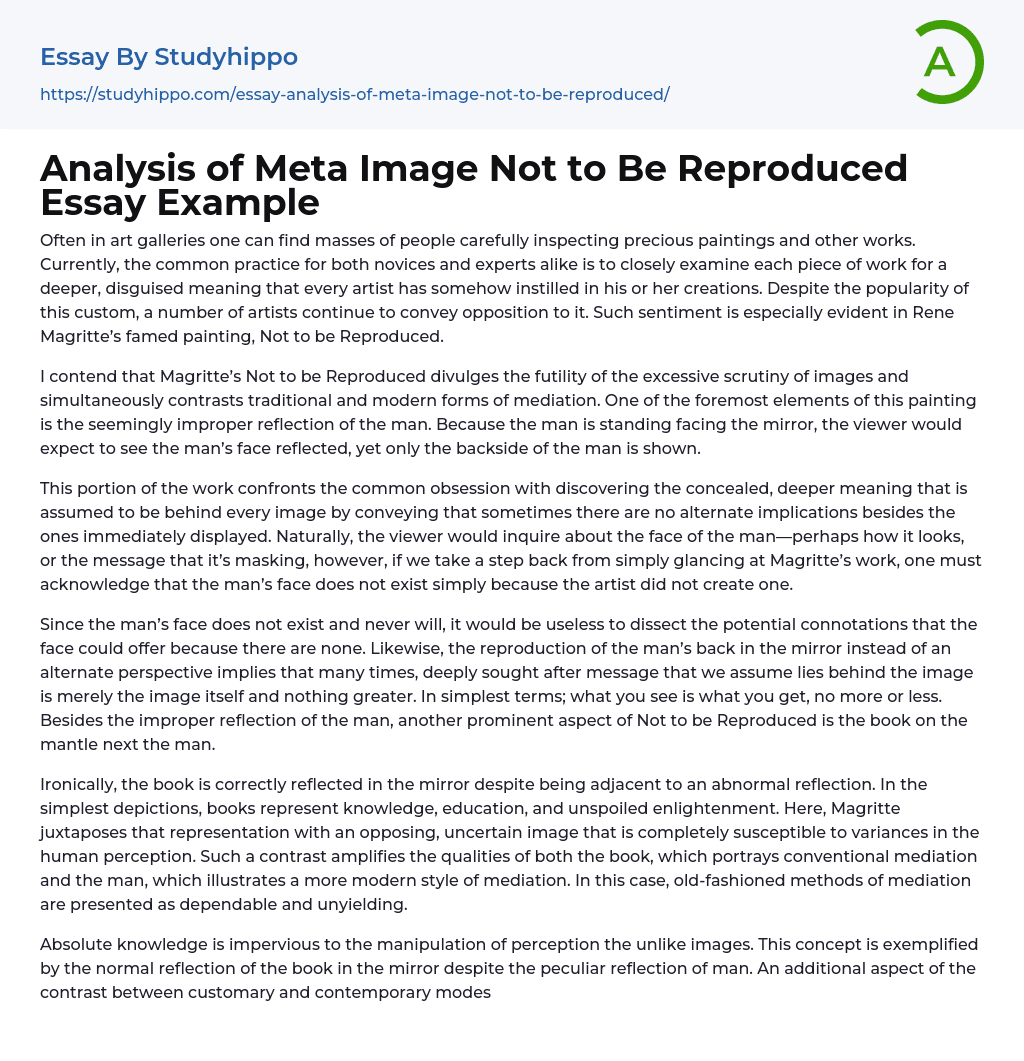

Analysis of Meta Image Not to Be Reproduced Essay Example
Often in art galleries one can find masses of people carefully inspecting precious paintings and other works. Currently, the common practice for both novices and experts alike is to closely examine each piece of work for a deeper, disguised meaning that every artist has somehow instilled in his or her creations. Despite the popularity of this custom, a number of artists continue to convey opposition to it. Such sentiment is especially evident in Rene Magritte’s famed painting, Not to be Reproduced.
I contend that Magritte’s Not to be Reproduced divulges the futility of the excessive scrutiny of images and simultaneously contrasts traditional and modern forms of mediation. One of the foremost elements of this painting is the seemingly improper reflection of the man. Because the man is standing facing the mirror, the viewer
...would expect to see the man’s face reflected, yet only the backside of the man is shown.
This portion of the work confronts the common obsession with discovering the concealed, deeper meaning that is assumed to be behind every image by conveying that sometimes there are no alternate implications besides the ones immediately displayed. Naturally, the viewer would inquire about the face of the man—perhaps how it looks, or the message that it’s masking, however, if we take a step back from simply glancing at Magritte’s work, one must acknowledge that the man’s face does not exist simply because the artist did not create one.
Since the man’s face does not exist and never will, it would be useless to dissect the potential connotations that the face could offer because there are none. Likewise, the reproduction of
the man’s back in the mirror instead of an alternate perspective implies that many times, deeply sought after message that we assume lies behind the image is merely the image itself and nothing greater. In simplest terms; what you see is what you get, no more or less. Besides the improper reflection of the man, another prominent aspect of Not to be Reproduced is the book on the mantle next the man.
Ironically, the book is correctly reflected in the mirror despite being adjacent to an abnormal reflection. In the simplest depictions, books represent knowledge, education, and unspoiled enlightenment. Here, Magritte juxtaposes that representation with an opposing, uncertain image that is completely susceptible to variances in the human perception. Such a contrast amplifies the qualities of both the book, which portrays conventional mediation and the man, which illustrates a more modern style of mediation. In this case, old-fashioned methods of mediation are presented as dependable and unyielding.
Absolute knowledge is impervious to the manipulation of perception the unlike images. This concept is exemplified by the normal reflection of the book in the mirror despite the peculiar reflection of man. An additional aspect of the contrast between customary and contemporary modes of mediation presented in this piece is the implied prominence of each. Although the book is shown as the reliable form of mediation, it is obviously less prominent in this context. One major indicator of this is the noticeable shadow cast over the book from the man standing next to it. Typically, shadows represent evils or the unknown.
Because of the shadow that absorbs nearly half of the book, any potential detail
of meaning to be derived from the presence of the book in the painting is made more mysterious, and thus lessened in comparison to the man. The shadow transforms the book from a potentially equal factor in the work to a less outstanding object. Likewise, the contrast between old and new mediation is alluded to by the size of each representing factor in the work. The man in the mirror towers over the book to the right of him and more often than not, greater size signifies greater importance.
So, despite the consistency and invulnerability that the book represents, the opposite is allotted greater value. In short, Magritte’s Not to be Reproduced conflicts with the typical practices of examining artwork. He mocks the seemingly incessant search for a “deeper meaning” in art by creating a concealed message that is identical to the one clearly shown and draws a striking contrast between traditional and contemporary forms of mediation. Overall, any examination of this work will lead to an examination of the way we perceive images and the messages they have to offer.
- Tattoo essays
- Clothing essays
- Footwear essays
- Fashion design essays
- Cosmetic Surgery essays
- Jeans essays
- Anatomy and Physiology essays
- Addiction essays
- Biodegradation essays
- Dental Care essays
- Disease essays
- Disorders essays
- Health Care essays
- Intelligence Quotient essays
- Nutrition essays
- Olfaction essays
- Public Health essays
- Women's Health essays
- World health organization essays
- Cancer essays
- Infectious Disease essays
- Lung Cancer essays
- Neurology essays
- Physical Exercise essays
- Medicine essays
- Sex essays
- Inquiry essays
- Disability essays
- Poison essays
- Action Potential essays
- Nervous System essays
- Childbirth essays
- Puberty essays
- Blood essays
- Kidney essays
- Neuron essays
- Body essays
- Glucose essays
- Sense essays
- Heart essays
- Skeleton essays
- Human Physiology essays
- Eye essays
- Immune System essays
- Muscle essays
- Skin essays
- Brain essays
- Central Nervous System essays
- Human Skin Color essays
- Digestive System essays



